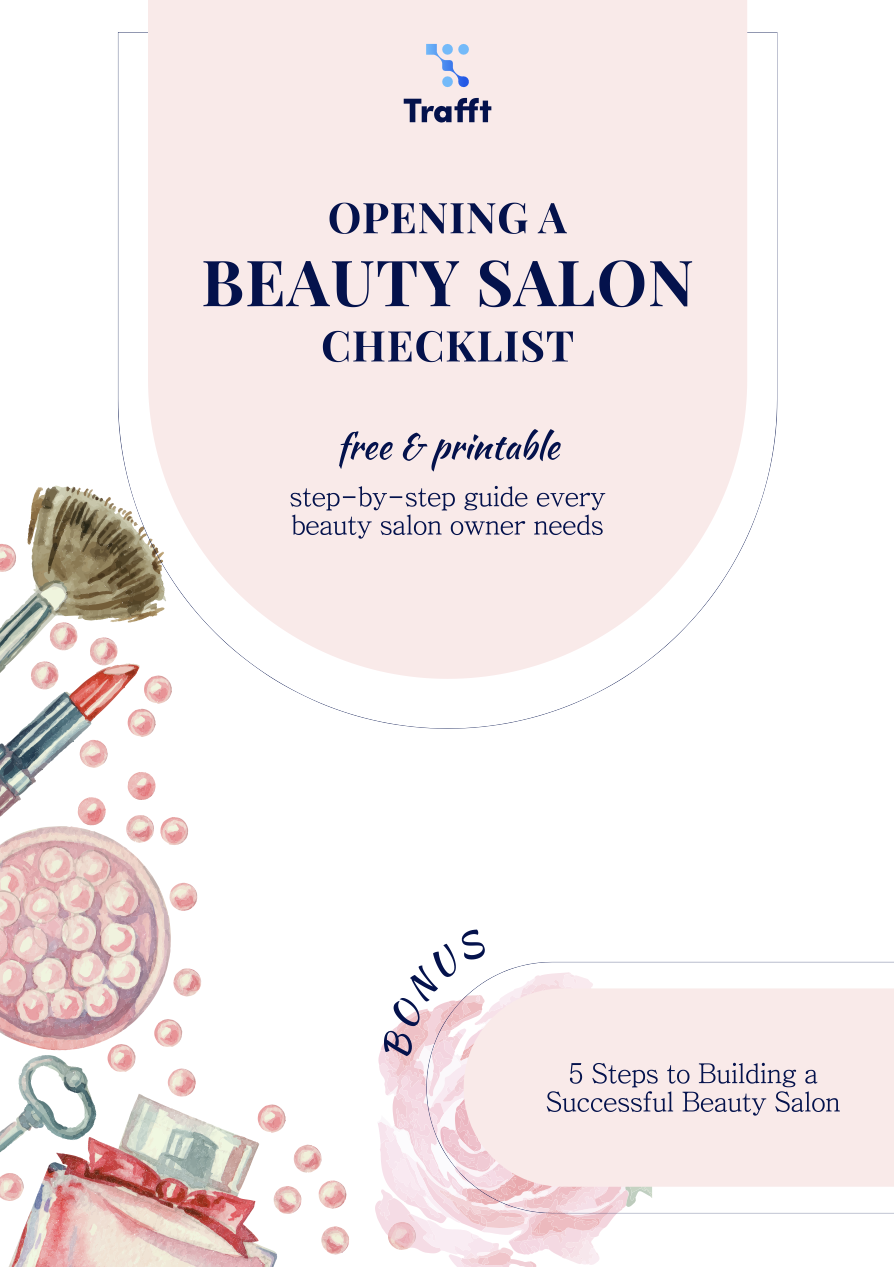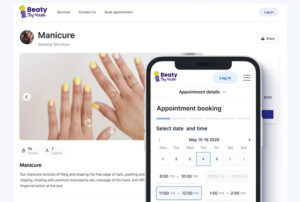If you plan to open a salon, besides setting the objectives, you'll need to know how you're going to achieve them. Or, in other words, you need a sound salon business plan.
Creating a salon business plan can help you identify specific goals and strategies, as well as provide guidance on how you can reach them and see your business thrive. Knowing how to craft your plan is vital, as it can easily make or break your salon business.
This article will walk you through how to create a salon business plan step-by-step.
Thank you for subscribing. Check your mail for details
What is a Salon Business Plan?
A salon business plan is a formal, written statement of the goals you want to set for your business. It explains why you want to set those goals and what your plan is for reaching them. A salon business plan might also include information about the individuals or teams working toward those goals with you.
A good salon business plan gives an overview of where your business is at now and explains where you want to be in the future. It also includes marketing information and research that impact your business plan in general. In fact, think of your salon business plan as a road map where you show where you are now and explain where you're headed and what it will take to get there.
As you build your salon business plan, it's important to include information about the process of opening your salon. This information is important because, right from the get-go, you lay the groundwork for success. This groundwork then helps you run and grow your salon business.
Benefits of Having a Sound Salon Business Plan
A well-crafted salon business plan comes with many benefits:
- A Greater Success Rate: A good business plan allows you to mitigate risks, make better-informed decisions, and improve your chances of running a successful salon.
- Better Financial Management: A well-written salon business plan includes your budget, financial projections, and expense management. This helps you keep tabs on your salon's financial health, which leads to financially sound decisions.
- Improved Marketing Strategies: A sound business plan requires you to conduct market research and develop marketing strategies. Then you can identify your target market, predict customer preferences, and adjust your marketing efforts to be more effective.
- Increased Operational Efficiency: A salon business plan ensures that you implement efficient operational processes. This allows your salon to keep running smoothly and leads to increased customer satisfaction.
Why is a business plan essential for the success of your salon?
A salon business plan is an essential tool for the growth and success of any salon. It is important as it helps you to jot down your ideas and thoughts, arrange them in an organized manner, and develop an overall plan to implement them.
Writing a salon business plan also enables you to identify potential difficulties and challenges that may arise in the future. Once you've identified them, you can create a strategy to address them.
If you have a salon that is already established and doing well, it might seem like a lot of work and trouble to sit down and make a business plan. But if you want your salon to keep thriving and growing, having clearly defined goals and plans is really important.
How to Write a Salon Business Plan in Just 12 Steps
- Write an executive summary
- Create effective mission and vision statements
- Include a salon business description
- Analyze the market and identify your target audience
- Check what your competitors are up to
- Identify products and services you wish to offer
- Craft a sound financial plan
- Tackle management and organization
- Plan your everyday operations
- Think about your marketing strategy
- Think about sales
- Don't forget to include risks
1. Write an Executive Summary
An executive summary explains what your salon is like and why it is successful. In most cases, a potential investor would go straight to this section to get an idea of what the business is like. If the executive summary isn't interesting or compelling, they won't read any further. That makes it an essential section and the first step when writing your salon business plan.
The executive summary should include information that is relevant to stockholders or investors. Include details about your target market, business objectives, and financial projections. Don't forget to add information about your products and service menu, as well as your vision and mission. The main idea is to let the reader know what's up, grab their attention, and make them want to keep reading.
Key components
An executive summary of every salon business plan should include the following information:
Business overview: Introduce the reader to your salon. Include information like the name and location, and a brief description of your core values, vision, and mission.
Market analysis: Provide a summary of your research on your target market. Include details about the target market's trends and demographics. Then highlight gaps or opportunities in the market that you plan to capitalize on.
Your business objectives: Clearly identify your business goals and state what you want your salon to achieve. This might include details like expansion plans, revenue targets, or customer acquisition goals. In this section, you can include any goals that will affect your salon's growth and success.
Products and Service menu: Give a brief overview of what your salon offers. Make sure your unique features and competitive advantages stand out. Explain what your salon is doing to meet the needs of the target market.
Marketing strategies: Explain your marketing strategy. This includes information about advertising, branding, social media, and so on. If you have any original ideas for how to make your salon stand out from the competition, make sure to highlight them.
Your financial projections: Provide a detailed financial plan overview. Include any information about profit targets, expenses budget, and revenue forecasts. Highlight any achievements or milestones you have reached that prove the financial viability of your salon.
Any funding requirements: Clearly explain the funding requirements for your salon. Explain how much funding you need, how you will use the funds and any other potential sources of funds you have.
2. Create Effective Mission and Vision Statements

Image by pch.vector on Freepik
A mission statement is a short explanation of why you created your salon, what your goal is, and how you want to achieve it. Your mission statement is an important part of your salon business plan, so it should be the first thing you see on the page. It's a good idea to put it at the top of the page where you and others can see it and be reminded of your purpose.
The mission statement gives you the chance to express your purpose and intention. It not only explains why you started the salon, but it also explains what you have to offer. It shows what sets you apart from the competitor salons and captures the spirit with which you run your salon.
In just a few words, your mission statement can determine what drives your business.
Defining your purpose and aspirations
Part of the purpose of a mission statement is to define your purpose and what you offer. Your purpose is the reason you exist and what you have to offer potential customers. To get an idea of what your mission statement should include, ask yourself "Why does my salon exist?"
A vision statement serves a similar purpose. It explains where you want to take your business and what you hope to achieve. It defines your goals and the future impact you want to have. To identify the key points that will go into your vision statement, ask yourself "Where do I see my salon in the future?"
Putting your purpose and your long-term goals in writing plays an important role in having a successful business plan.
How to craft mission and vision statements
Here are a few examples of things you can consider when you are writing your mission statement and your vision statement. This will help you come up with ideas that reflect your identity and direction as a salon.
- Have a brainstorming session with your team. Ask them "What do you think makes this salon unique? What do you love about working here? What do you personally want to achieve?"
- Identify core values. What specific values do you want to uphold in everything you do? Some examples of core values are: creativity, integrity, excellence, diversity, and
- Put your mission statement in writing. Use your core values as a starting point. Then write a short, simple sentence that sums up your salon's purpose and what you offer to clients.
- Write your vision statement. Write a short, inspiring sentence that describes your long-term goals for the salon and what you want to achieve.
- To make this process easier, consider using AI writing tools to help craft clear and compelling statements.
- Review and refine. Once you have your mission and vision statements written down, take some time to review them. Make sure your statements are both clear and concise, as well as compelling.
In case you need a bit of help, take a look at some brilliant salon mission statement examples sure to inspire you.
Also, writing an effective slogan will only underline the message you wish to send, so make sure you have one ready.
3. Include a Salon Business Description
Salon description
A company description is a quick overview of your business that explains the core values of your company. This part of your salon business plan is all about giving a quick and simple rundown to the readers. It's meant to give them a general idea of what your business is all about.
Outlining the details
Your salon business description provides all the basic details about your salon. You should include the name of your salon, the location, and your contact information. Also, include the details about the legal structure of your salon. This information is the foundation of the rest of your business description. Thus, it's important that the information is accurate and up to date.
Company history and brand story
In this section, you should provide some information about the background and history of your salon. When was your business founded? What led to you starting your business? Whatever your story is, this section is your chance to tell it.
Describe what you offer and your USP
This section details what your clients can expect to find at your salon. You can use this section to provide details about new beauty products or services you are offering. If you are working on your own line of products, this is also a good place to mention it and provide an estimated timeline for when it will be available.
Your salon's USP (unique selling proposition) is what makes your salon stand out from the rest of the market. It is very important to highlight your USP in your business description.
4. Analyze the Market and Identify Your Target Audience
The market analysis shows that you've put some serious thought into your target audience. You've also done some research to find out what the competitors are missing out on. What's more, it shows that you really know your area and have made some changes to your approach to fit in.
When you identify and analyze your potential clients, you are better able to adjust your marketing strategy to catch their eye.
Conducting market research
Market research means collecting data about the needs, preferences, and behavior of potential clients. Then you analyze this data. Tools like market intelligence software can help you do this faster and more accurately, giving you a clearer picture of your target audience and the market around you. Market research helps you identify who your target market is and what their expectations and needs are. Based on these findings, you can create a marketing strategy that is appealing to that audience in particular.
Conducting market research also helps you identify who your competition is. Knowing this helps you get a good idea of reasonable pricing and ideal locations. Factoring this information in helps you gain and retain clients.
Here are some ideas on how you can make the entire process more interactive and fun (both for you and the participants):
Salon pop-up surveys
Set up a pop-up booth or station near popular local spots and events. Engage with passersby, offering quick surveys with a fun incentive like discount coupons for your salon. This allows you to gather diverse opinions and attract potential customers.
Instagram polls and stories
Leverage the interactive features of social media. Use Instagram polls and stories to ask your followers about their favorite salon experiences, desired services, or beauty trends. Encourage them to share their thoughts and tag friends for a chance to win a free service.
Salon open house events
Host an open house event at your salon. Invite the local community to explore your space, meet your staff, and participate in live demonstrations or mini-makeovers. Use the opportunity to collect feedback and preferences directly from attendees.
Collaborative mood boards
Create collaborative mood boards or Pinterest boards where clients and potential clients can contribute their favorite hairstyles, colors, and beauty inspirations. This not only gathers valuable insights but also fosters a sense of community and involvement.
Beauty trend workshops
Organize workshops on the latest beauty trends. Invite participants to share their thoughts on emerging styles and treatments. This not only serves as a research platform but also positions your salon as a trendsetter in the community.
Community surveys with prizes
Distribute physical or digital surveys within the local community, emphasizing the importance of their opinions. Include a prize draw or a special discount for survey participants, encouraging more people to contribute.
Interactive social media challenges
Create engaging challenges on social media platforms, encouraging followers to share their favorite salon experiences or dream makeover ideas. Use a unique hashtag to track responses and offer prizes for the most creative entries.
Beauty polls and quizzes
Develop entertaining online polls or quizzes related to beauty and salon preferences. Share these on your website and social media to capture audience insights while providing a fun and interactive experience.
By infusing creativity and engagement into your market research efforts, you not only gather valuable information but also strengthen the connection between your salon and the community. The more interactive and enjoyable the process, the more likely you are to receive enthusiastic and authentic responses from your audience.
Identifying behaviors, demographics, and preferences
Once you have information on your target market you can use it to better understand them. Here are a few things to look at:
The behavior of your target market. This refers to the way clients make purchasing decisions, their brand loyalties, and other similar behaviors. In general, behaviors can include anything that affects a client's decision-making process.
Demographics refer to the characteristics of your potential clients.
Geographic location, educational background, and income can all impact the way clients respond to your marketing strategy.
Even the age and gender of the people you want to draw in can affect which strategies you use. Understanding this will help you create a marketing plan that resonates with the clientele you want to attract.
Then you have to factor in the preferences of your target market. What do they like and dislike? What kinds of ambiance are they drawn to? Which salon services are most popular with this group? What are their thoughts on pricing? What do they look for in customer service? All these factors play their part in whether or not a potential customer chooses your salon.
Client analysis
This part of your salon business plan is all about who your potential clients are. Depending on where your salon is, you might get certain types of people coming in. Or, it might be a mix of different types. You need to include details about who your market is made up of and what they're like.
Here are a few things involved in conducting a client analysis for your salon:
- Define the scope and the objective of the analysis. Include information about the services and products, the time frame, and the area your customers are coming from.
- Collect data from a variety of sources and analyze. You can use surveys, online reviews, industry reports, interviews, and social media, as well as other sources.
- Identify specific customer groups. This includes demographics, needs, and behaviors.
- Create a profile for each customer group. Include descriptions of preferences, characteristics, expectations, and motivations.
- Evaluate the salon's current performance. How are you doing with customer retention, satisfaction, and loyalty? How much is your salon profiting?
- Identify specific areas where you can improve customer relationships.
5. Check What Your Competitors Are Up To
A competitive analysis explains your plan for your salon to dominate the market. It is important for your competitive analysis to give a brief explanation of the existing competitors. This can include direct competition, like another salon, or indirect competition. The indirect competition includes any other option for clients to receive the products or services you offer. In this section of your salon business plan, you can bring out the strengths and weaknesses of your competition and explain how your target market views them.
Knowing your competition will help you determine what your own advantages are. Then you can capitalize on those advantages to attract and keep more customers. Once you can pinpoint your unique strengths, you are better equipped to carve out your own place in the market. It will give you a starting point to work from to identify a new way to attract customers. It may also help you find something unique to offer that no one else in the area is offering.
Conducting a SWOT analysis
To be able to succeed and stand out from the competition, it is helpful to carry out a SWOT analysis. SWOT is an acronym for strengths, weaknesses, opportunities, and threats. This analysis will help you diagnose the factors that play a role in the potential and performance of your competition.
What are the strengths of your competitors? Maybe a competing salon has a good reputation and a strong brand. Perhaps they offer a wide range of services or have a skillful team. They might have a good relationship with their suppliers, offer a clean and welcoming atmosphere, or have an optimal location.
What are their weaknesses? Perhaps they offer a limited number of services or have staff that lacks experience. They might be struggling with high overhead costs or have a difficult location. Or they may be on the losing end of high competition and/or struggle to maintain customer loyalty.
Opportunities for a salon include expansion opportunities or new services and products. Other opportunities include increased online presence, partnering opportunities, or new technology and trends.
What is a threat to a salon? Economic recessions, loss of customers to the competition, and negative reviews all threaten the success of a salon. Other threats include supply chain disruptions, legal problems, and environmental and health risks.
6. Identify Products and Services You Wish to Offer
This part of your salon business plan lays out all the different services that your salon will offer its customers. You can expect a wide range of services, from haircuts, styling, coloring, treatments, manicures, pedicures, facials, and many more. Each service is described in detail, including the techniques used, expected results, and pricing structure. You can also offer a great selection of salon products that customers can buy, like hair care items, skincare products, and beauty accessories.
By providing a comprehensive overview of the salon's products and services, you're showing that you're committed to meeting all customers' needs and preferences. You want to make sure everyone feels welcome and satisfied with their experience at your salon. This sets the stage for a successful and thriving salon business.
7. Craft a Sound Financial Plan

Image by vectorjuice on Freepik
Here is where you provide details about the financial history, budget, and projections for your salon. Any potential investors or lenders will be especially interested in this section of your salon business plan.
When writing this section, you should include your financial plan for your salon for the next 3-5 years, as well as your financial history going back 3-5 years. If the salon has income, include financial statements. You should also include potential funding sources and your plan for keeping your salon running.
Budgeting
A good budget is the foundation for any effective financial plan. A budget allows you to distribute resources like time and funds effectively. A good budget also allows you to make better decisions about saving and spending and set goals for your finances.
Start by identifying all the sources of income for your salon. This includes product sales, service fees, and so on. Then identify all the expenses your salon has, like rent, salaries, supplies, and other operational costs. You could make a category for expenses that are always the same, like rent, and another for expenses that vary from month to month, like supplies. This might help you to see patterns and identify areas where you could cut back on some costs.
Once you have identified all your income and expenses, then you can set goals. From time to time, check your progress against your budget to see how you are doing and if you can make any further adjustments.
Income streams
Adding income streams is a good way to increase revenue. The following are a few options you could explore:
- Subscriptions: Charge fees for a set period of time instead of per transaction.
- Advertising: Promote certain brands in-store and online.
- Freemium plans: Certain services are free and “premium” services cost extra.
- Third-party licensing: Give third parties the right to use or sell your patented products.
- Renting or Leasing: Rent out assets (for example, real estate or products) for a price.
As you create your financial projections, factor in the demand in the market and the volume of customers. You should also include your pricing strategy for the products and services you offer. It would be helpful to go back and review your sales history. Then you can isolate specific trends. This will help you make more sound financial decisions moving forward. It would also be helpful to you to do some research on the current market.
Alternative funding options
There are a variety of options when it comes to alternative funding sources for your salon. Each option has pros and cons. Some options include loans, grants, crowdfunding, or partnerships.
Loans may offer somewhat low interest rates. However, it's important to find out what they require for collateral or how strict the repayment terms are.
Grants can offer funds that you don't have to repay, but they might have strict eligibility requirements and limits on how you can use the funds.
Crowdfunding can get you funds from a pool of investors, but it might mean sharing control or ownership of your salon.
Partnerships can get you access to extra capital and more expertise. On the downside, partnerships can mean profit-sharing. You may also have to consult with your partners before you make decisions.
Expense management
If you want your salon business plan to have success, it is vital that you manage your expenses carefully. To maximize your earnings, you have to optimize your expenses and control the costs your salon faces. This is the only way to make sure that your salon remains financially stable.
Regularly review your expenses and identify ways to cut costs without sacrificing quality. Be on the lookout for chances to negotiate better deals on supplies and cut out unnecessary expenses. For example, could you choose equipment that is more energy efficient? Is there a way you could maximize the lifespan of the products you use and cut back on supply costs?
Hiring freelancers or contractors
Hiring a contractor or freelancer can have a lot of benefits. These independent professionals can provide you with the expertise you need to do a specific project or task. Some of the benefits they offer include:
- Saving on Costs: Hiring contractors and freelancers can save you money on payroll taxes, training, benefits, and more. You pay for the work they do and depending on your needs you can adjust your budget.
- Greater flexibility: You hire contractors and freelancers only as you need them and for as long as you need. You can adjust the scale of your team depending on the demand of the project and their availability.
- Expertise: Freelancers and contractors bring in fresh ideas and perspectives. Their knowledge of the industry is also an asset to your salon business. They can also carry out tasks that are beyond your skill set or that require special equipment and tools.
8. Tackle Management and Organization
The management and organization plan is the backbone of your salon business plan. It shows how your salon will operate and reach its goals. This section gives an in-depth look at the salon's management team, including their beauty qualifications, experience, and roles inside the salon. It also explains how the salon will be structured, how decisions will be made, and how different teams will work together.
By sharing a clear management and organization plan, your business plan shows that the salon has capable people and a well-structured system to make it in the competitive beauty industry.
9. Plan Your Everyday Operations
The salon's operational plan outlines the day-to-day procedures and practices that drive the smooth functioning of the salon. It covers all the essential operational aspects, from staff scheduling and client management to inventory control and quality assurance.
The plan sets out who's responsible for what, so everyone works together like a team to give customers the best service. It includes strategies for optimizing appointment bookings, managing walk-ins, and handling peak hours efficiently.
Moreover, the operational plan addresses health and safety protocols, emphasizing the importance of maintaining a clean and hygienic environment for both clients and staff. By adhering to the operational plan, the salon can enhance productivity, elevate the overall customer experience, and create a thriving and well-organized salon environment.
Implementing booking software into your salon's everyday operations
As a forward-thinking salon owner, integrating booking software into your daily operations isn't just a tech-savvy move - it's a strategic investment that brings a myriad of benefits to your business.
Booking software simplifies the appointment process, allowing clients to schedule services seamlessly. With real-time updates, your staff can manage and optimize appointments, reducing the risk of scheduling conficts and ensuring a smooth workflow.
Also, booking software enables you to create and manage staff schedules effortlessly. With automated notifications and reminders, your team stays informed, reducing scheduling conflicts and enhancing overall productivity.
Not to mention that clients appreciate the convenience of booking online, as it allows them to be in charge of everything - they can choose services, select preferred staff members, and book appointments at their convenience.
Revolutionize Your Salon Booking with Trafft: A Solution Tailored for Salon Owners
As a salon owner, you're no stranger to the challenges that come with managing a bustling beauty business.
Managing appointments, handling last-minute rescheduling, dealing with overbooking, creating and managing staff schedules, and struggling to be there for your clients in the middle of the night - these are just some of the common pain points you face as a salon owner.
Enter Trafft! Tailored with your specific challenges in mind, Trafft is designed to transform your daily chaos into an efficient salon experience.
What do you get from Trafft?
- Say Goodbye to Daily Organizational Chaos: Bring order to the chaos with real-time updates and efficient scheduling. Trafft makes organizing your calendar, keeping track of appointments, and managing staff schedules a breeze.
- Minimize No-Shows: With Trafft's automated reminders, you can reduce no-shows and make sure that each appointment slot is valuable. You'll receive timely notifications via email or SMS which will help you cultivate a reliable and engaged customer base.
- Reschedule with Ease: When your clients choose a new time, Trafft will send notifications to both of you. Plus, it'll confirm the booking and update all your calendars. No need to worry about canceling an appointment - Trafft will do it for you!
- Be Available 24/7: Allow clients to schedule appointments at their convenience. Transform your salon into a 24/7 beauty oasis, breaking free from traditional booking hour constraints.
So, are you ready for a salon management revolution? Embrace Trafft and start your transformation now!
10. Outline Your Marketing Strategy in Salon Business Plan
This is your game plan for your salon to bring in new clients and promote your services. A thorough marketing plan, with plenty of marketing ideas and marketing tools you plan to use, is essential. It allows you to stand out from the competition and reach your target market. It also allows you to create connections with your customers and achieve your marketing goals.
This is the most flexible section of your salon business plan. As your business grows and the market changes, your marketing plan will adapt to it.
Marketing strategies that attract and retain clients
It's important for salon owners and managers to create strategies for advertising and marketing. This helps to attract new customers and retain existing clients, as well as improve the reputation and visibility of the salon. Here are a few strategies you might try:
- Create a salon website or social media account. There customers can get information about your prices, services, location, and hours. Websites and social media accounts are great ways to showcase your work or advertise special events and promotions.
- Try offering discounts, coupons, referrals, loyalty programs, or gift cards. This will encourage customers to visit the salon more frequently and make them more likely to spread the word to friends and family.
- Participate in local events. Are there any festivals, fairs, charity drives, or fashion shows coming up? These events are a great opportunity for the salon to showcase its skills and services. It also gives you the chance to network with potential customers and partners and generate publicity.
- Look for opportunities to partner with other local businesses like spas, hotels, gyms, or restaurants. You can cross-promote services and offer deals or packages to shared customers.
- Send emails or newsletters to customers about your latest news, tips, beauty trends, and offers.
- Ask for feedback from customers. Then use their responses to improve customer satisfaction and quality of service.
11. Think About Sales
In this section of your salon business plan, you should outline the strategies and tactics that will be employed to drive revenue and achieve your salon's financial objectives.
This section delves into the target market and defines the salon's unique selling proposition, emphasizing what sets it apart from competitors. It details the pricing strategy for various services and products, taking into consideration factors such as market demand, competition, and the perceived value of offerings.
The sales plan also identifies promotional activities and marketing campaigns that will be executed to attract new clients and retain existing ones. It includes a timeline for these initiatives, along with a budget allocation for marketing expenses. Furthermore, the section discusses techniques for upselling and cross-selling to maximize the average transaction value per customer.
By laying out a comprehensive sales plan, the business plan showcases the salon's dedication to achieving financial success and growth through a well-structured and effective sales approach.
12. Don’t Forget to Include Risks
The risk management section of the salon business plan addresses the potential challenges and uncertainties that the salon may encounter during its operations.
This section identifies and assesses various risks, including financial, operational, legal, and industry-specific risks. It outlines the proactive measures that will be implemented to mitigate these risks and ensure business continuity.
Strategies such as obtaining insurance coverage, adhering to strict health and safety protocols, implementing sound financial practices, and conducting regular staff training are discussed to minimize potential liabilities. Additionally, contingency plans are detailed to handle unexpected situations, such as economic downturns or natural disasters.
By carefully analyzing and addressing potential risks, the risk management section demonstrates the salon's commitment to safeguarding its interests and building resilience, providing potential investors and stakeholders with confidence in the salon's ability to navigate challenges and succeed in the long run.
So, What’s the Secret to Creating a Successful Salon Business Plan?
Running a successful salon requires more than just a flair for aesthetics; a robust salon business plan is equally essential. This plan is not a one-time document but a dynamic tool that evolves alongside your business. It serves as a roadmap, guiding your financial decisions, attracting funding, and steering your salon toward lasting success.
When writing your salon business plan, don't forget to include a detailed market analysis, your financial projections, operational plan, services and pricing strategy, marketing, and branding.
Be sure to check in on your plan regularly and see how you're doing compared to your goals.
Looking for More Salon-Related Resources?
If you enjoyed this article about creating a successful salon business plan, you should check out these as well:
- The Best Salon Appointment Booking App On the Market
- How To Manage A Salon Successfully (Salon Manager Tips)
- How To Run A Successful Salon (The Salon Owner Guide)
- How To Get More Clients In A Salon (The Ultimate Guide)
- How Much Do Salon Owners Make? Tips for You to Earn More
- Salon Cancellation Policy Examples and Templates To Use
- The Best Salon Slogans and Mottos to Use for Your Own
- Salon Mission Statement Examples and Tips To Create One
- The Types of Salon Insurance You’ll Need for Your Business
- Salon Social Media Marketing 101
- How to Make a Salon Price Increase Notice without Losing Clients
- The Most Efficient Salon Marketing Ideas You Need To Try
- The Best Salon POS System to Pick From
- Salon Booth Rental Tips and Best Practices to Know
FAQs on Salon Business Plan Essentials
How to write a salon business plan?
Start with an overview of your salon concept, target customers, and services, then outline your pricing, marketing, and financial projections. A clear plan helps you stay organized and attract investors or loans.
How profitable is a salon business?
Salons can be highly profitable if they manage costs wisely, build a loyal client base, and maintain consistent service quality. Profit margins often improve once initial setup costs are recovered.
How do I start a simple salon business?
Begin by researching your market, choosing a niche, and creating a basic salon business plan. Start small with essential services and equipment, then expand as demand grows.
Do you need a lot of money to start a salon?
It depends on your setup. A full-service salon requires more investment, while a small or home-based salon can start with modest costs by focusing on essential tools and services.
Why do I need a salon business plan?
A salon business plan is essential because it serves as a roadmap, guiding you through the process of starting and growing your business.
It outlines your goals, target market, services, pricing, and marketing strategies, helping you stay on track and make informed decisions.
A well-prepared business plan can also be valuable when seeking financing, as it demonstrates your commitment and expertise to potential investors or lenders.
What should I include in the company description for salon business plan?
In the company description, provide an overview of your salon, including the name, location, and ownership structure.
Explain your salon's mission, vision, and core values, as well as the unique selling points that set you apart from competitors. This section should also highlight the salon's atmosphere, target clientele, and the specific services you plan to offer.
What is an example of a salon mission statement?
An example of a salon mission statement could be: "At [Your Salon Name], we are dedicated to delivering exceptional beauty experiences that empower our clients to look and feel their best. Our mission is to create an inviting, inclusive environment where creativity thrives, and our team is committed to providing personalized, high-quality services that enhance natural beauty and boost confidence."
What is the best business structure for a salon?
The most common business structures for salons are Sole Proprietorship, LLC (Limited Liability Company), or Corporation. Each has its own advantages. Sole Proprietorship is simpler but offers less liability protection. LLC combines liability protection with flexibility. A Corporation provides strong liability protection but involves more complex formalities. Consult with a business advisor to determine the best fit for your salon.
How do I set salon pricing?
Setting salon pricing requires balancing the cost of providing services with what customers are willing to pay.
Research competitor pricing in your area and consider factors such as your target market, the quality of your services, and your salon's atmosphere. You can opt for tiered pricing based on the experience of the stylist or offer service bundles to encourage customers to try additional services.
Be prepared to adjust your pricing as your business grows and evolves.
What's the best way to market my salon?
Marketing your salon requires a combination of traditional and digital strategies.
Word-of-mouth referrals from satisfied clients can be powerful, so encourage customers to share their experiences with friends and family. Utilize social media to showcase your work, engage with potential clients, and share promotions.
Collaborate with local businesses or participate in community events to raise brand awareness. Don't forget about email marketing, loyalty programs, marketing tools, and targeted advertising to attract new customers and retain existing ones.
How can I ensure a top-notch customer experience?
Providing an exceptional customer experience is crucial for salon success. Start by hiring skilled, friendly staff who share your vision and commitment to customer satisfaction. Offer ongoing training to ensure your team stays up-to-date on industry trends and techniques.
Also, handle bookings professionally, with the help of salon scheduling software and booking apps.
Create a welcoming, clean, and comfortable salon environment, and be responsive to customer feedback. Consistently delivering high-quality services and personalized attention will help you build a loyal client base.
How do I manage salon inventory and supplies?
Effective inventory management is essential for a successful salon. Implement a system to track product usage and sales, ensuring that you always have adequate supplies on hand without overstocking. Regularly review your inventory levels and adjust your ordering frequency or quantities as needed.
Negotiate with suppliers for the best prices and consider implementing inventory management software to streamline the process.
How do I measure the success of my salon business?
Measuring the success of your salon business involves tracking key performance indicators (KPIs) that align with your goals.
Common KPIs for salons include revenue growth, client retention, client acquisition, average ticket value, and employee productivity.
Track these metrics regularly to assess your salon's performance and identify areas for improvement. Additionally, use customer feedback, online reviews, and testimonials to gauge the overall satisfaction of your clients and the quality of your services.
This information can help you refine your business strategies and ensure your salon's ongoing success.








